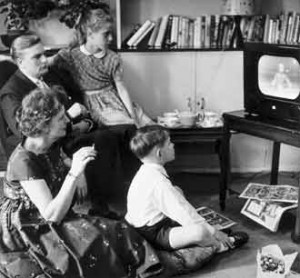Future of Mobile Ads
Accessing the Internet is being completely taken over by mobile devices. They are cheaper than laptops and desktops, more portable and apps have managed to fill whatever gap remained in the area between the front lobe and the rear cortex.  Advertising used to be a lot simpler.[/caption]
Advertising used to be a lot simpler.[/caption]
As a result, advertisers and marketers are having to play catch up-constantly trying to stay on top of the consumers' minds and eyes. Digital music is a perfect example. First, there was Napster and other free-sharing websites that you could basically get any song for free. Ironically, it was the billionaire soft rock (anymore) band Metallica that lead the fight for pay-to-hear music.
Napster evolved into iTunes, Spotify and Pandora. With iTunes, it's a simple exchange of cash for songs. Spotify is subscription based where a monthly fee will allow you to have access to millions of songs. With Pandora, however, making money off of the ears' enjoyment got a bit trickier.
Pandora controllers began placing advertisements in between songs, along with banner ads and scrollers that the user would have to click off in order to see their intended screen. That same creative implementation is going into mobile devices soon.
Just think of all the places. If you open an app, you see an ad. Hit a search button, there's an ad. How about not being able to open a browser until you type the word "Pepsi" into a box? But advertisers know they can't push too hard. Pandora lost a lot of listeners when they switched formats. But as soon as everyone else does it, it becomes accepted and almost expected.
Professional sports stadiums used to bear the name of the city, culture or area, like the old Cleveland Browns Stadium, Columbus Crew Stadium, Ohio Stadium, etc. You used to able to watch a dunk without the dunk being brought to you by so and so and such and such a product. But now no one notices. See you at the stadium, err, see you at First Energy Field.
 Advertising used to be a lot simpler.[/caption]
Advertising used to be a lot simpler.[/caption]As a result, advertisers and marketers are having to play catch up-constantly trying to stay on top of the consumers' minds and eyes. Digital music is a perfect example. First, there was Napster and other free-sharing websites that you could basically get any song for free. Ironically, it was the billionaire soft rock (anymore) band Metallica that lead the fight for pay-to-hear music.
Napster evolved into iTunes, Spotify and Pandora. With iTunes, it's a simple exchange of cash for songs. Spotify is subscription based where a monthly fee will allow you to have access to millions of songs. With Pandora, however, making money off of the ears' enjoyment got a bit trickier.
Pandora controllers began placing advertisements in between songs, along with banner ads and scrollers that the user would have to click off in order to see their intended screen. That same creative implementation is going into mobile devices soon.
Just think of all the places. If you open an app, you see an ad. Hit a search button, there's an ad. How about not being able to open a browser until you type the word "Pepsi" into a box? But advertisers know they can't push too hard. Pandora lost a lot of listeners when they switched formats. But as soon as everyone else does it, it becomes accepted and almost expected.
Professional sports stadiums used to bear the name of the city, culture or area, like the old Cleveland Browns Stadium, Columbus Crew Stadium, Ohio Stadium, etc. You used to able to watch a dunk without the dunk being brought to you by so and so and such and such a product. But now no one notices. See you at the stadium, err, see you at First Energy Field.





Have your say
Feel free to take part in the discussion! Please be nice and do not include any abusive comments or spam. All comments are moderated and MAXtech Agency reserves the right to delete any comment.